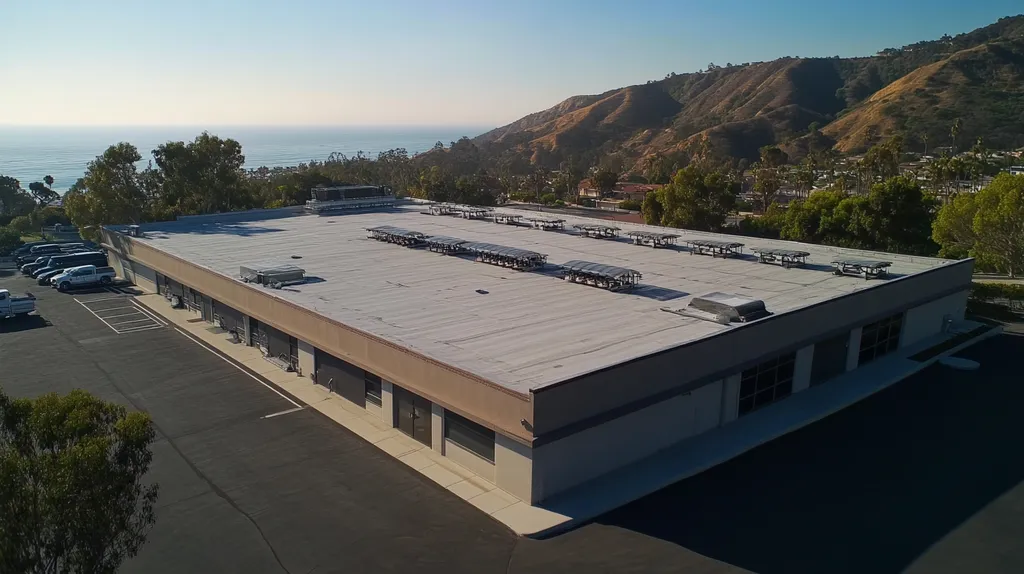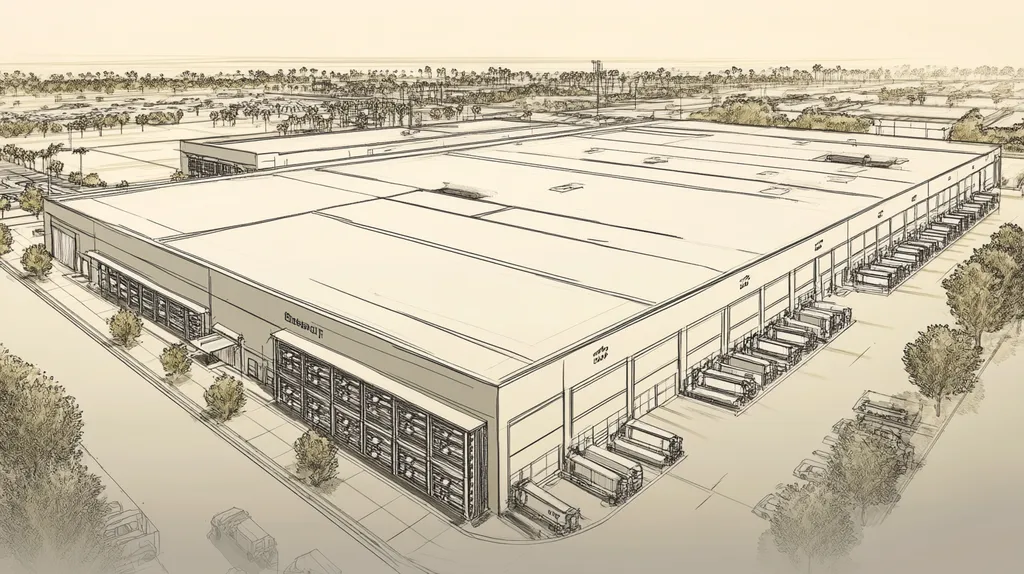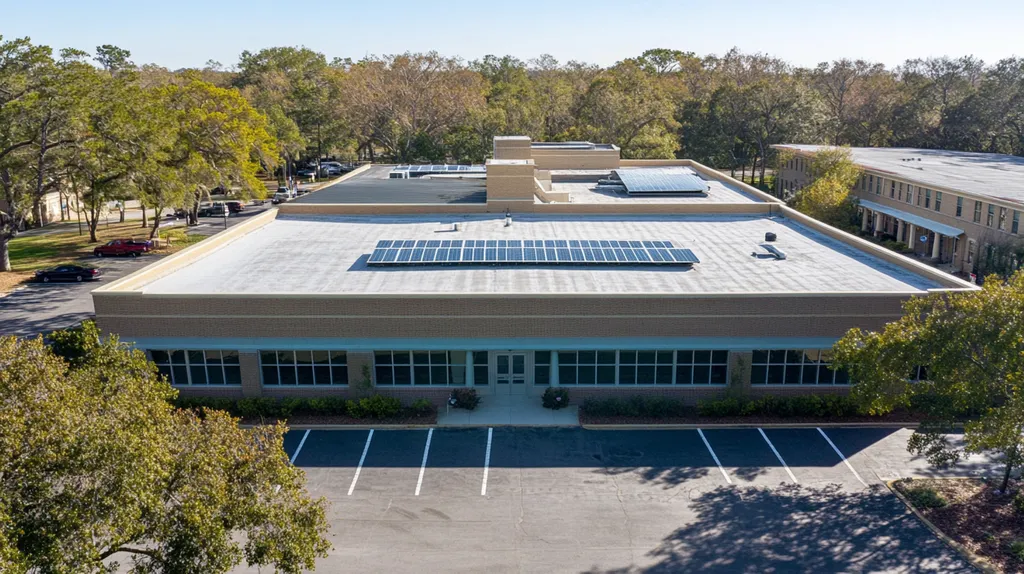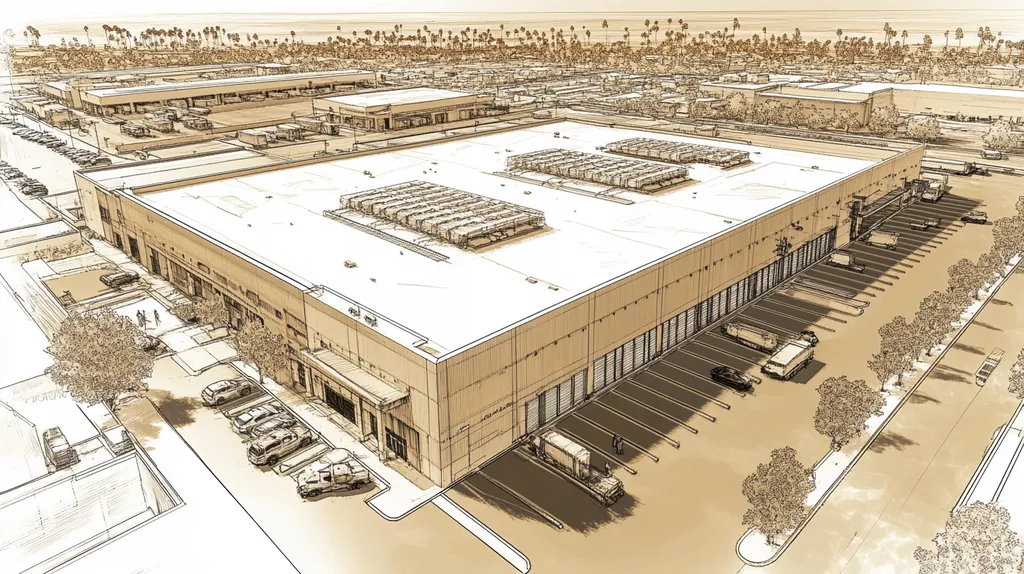In today’s commercial real estate landscape, over 80% of facility managers report that roofing issues are their most costly maintenance challenge. Water damage alone costs businesses billions annually in repairs and lost productivity.
Liquid coatings represent a critical solution for protecting commercial roofing assets, yet selecting the wrong coating system can lead to premature failure and extensive damage. Understanding key performance factors, financial implications, and compliance requirements is essential for success.
This comprehensive guide provides facility managers with actionable insights for evaluating liquid coating solutions, from initial selection through long-term maintenance considerations.
SECTION 1: PERFORMANCE FACTORS
Selecting the appropriate liquid coating for a commercial roofing system is essential for ensuring long-term success and protection. A resilient waterproofing solution can prevent costly leaks and extensive damage, while durable coatings save time and resources on maintenance. Alarmingly, studies reveal that over 60% of roofing problems stem from waterproofing failures. Therefore, facility managers must prioritize waterproofing efficiency, durability, and UV resistance in their decision-making process to mitigate disruptions and financial pitfalls.
Waterproofing Efficiency
Waterproofing efficiency is critical for safeguarding commercial roofs against water damage. A liquid coating should create a seamless barrier that blocks water intrusion. Coatings with high solids content typically perform better, offering superior adhesion and sealing capabilities.
It’s also vital to verify water resistance through third-party testing. Certifications from manufacturers can demonstrate a coating’s capability to withstand standing water and severe weather. Familiarizing oneself with these ratings helps facility managers choose the most reliable options for their climate.
Moreover, the coating’s reaction to extreme temperatures is crucial. Products that maintain flexibility during thermal expansion prevent cracking, bolstering waterproofing efficiency. Evaluating the complete performance range of liquid coatings is vital for preserving building assets.
Key Action Items
Durability and Lifespan
Durability is a key indicator of a coating’s lifespan and effectiveness. Facility managers should analyze the product life cycle of different coatings. For instance, coatings with warranties of over ten years signal long-term reliability.
The formulation of the coating significantly impacts its durability. Certain additives can enhance resistance to wear from foot traffic and harsh environments. Opting for a high-quality formulation can drastically reduce chances of premature failures.
It’s essential to follow industry best practices and select coatings capable of withstanding various stresses. For facilities in high-traffic areas, thicker applications might be necessary, especially for roofs supporting mechanical equipment or frequent maintenance.
Key Action Items
Resistance to UV and Airborne Contaminants
UV and airborne contaminant resistance is vital for preserving the integrity of liquid coatings. UV rays can degrade coatings over time, leading to cracks and compromised performance. Therefore, facility managers should prioritize products specifically designed to provide UV resistance.
In addition to UV exposure, airborne pollutants and debris can negatively impact a roof’s functionality. High-quality coatings create surfaces that prevent the buildup of dirt and contaminants, simplifying maintenance tasks.
The color and reflectivity of a coating also play essential roles in its performance. Lighter colors enhance reflectivity, keeping roof temperatures lower and contributing to energy savings. Selecting the right color and reflective properties can yield long-term benefits for energy efficiency.
Key Action Items
SECTION 2: FINANCIAL CONSIDERATIONS
When it comes to the financial aspects of commercial roofing, choosing the right solution is crucial for the organization’s overall success. Liquid coatings can often be a more affordable option, but many facility managers might not realize their long-term financial benefits. By conducting thorough financial assessments, managers can make choices that enhance roof durability and significantly decrease ongoing maintenance costs.
Initial Installation Costs
Initial installation costs for liquid coatings can differ based on the building’s size and roofing type. Generally, these coatings are a more budget-friendly choice compared to traditional roofing materials, allowing facilities to conserve capital. For instance, applying liquid coatings may range from $2 to $4 per square foot versus $5 to $10 for traditional roof installations.
Also, the application of liquid coatings is typically quicker, translating to reduced labor expenses. Many contractors can finish the installation in just a few days, which minimizes business disruptions and allows facilities to resume normal operations swiftly. This expeditious process can help cut down on downtime.
However, it’s important for facility managers to gather multiple quotes and assess the quality of materials. While higher-quality liquid coatings may come with a steeper upfront price tag, their enhanced durability and performance can lead to significant cost savings in the long run. Hence, initial installation costs should be understood as part of a comprehensive financial strategy.
Key Action Items
Long-Term Maintenance Savings
Liquid coatings offer substantial long-term savings in maintenance compared to conventional roofing systems. These coatings provide essential protection against UV rays, heavy rain, and extreme temperatures, prolonging the lifespan of the underlying materials.
For example, facilities that use liquid coatings can expect a marked decrease in leaks and water damage over time. This reduced vulnerability translates to fewer repair costs, which can be substantial when compared to a traditional roofing setup. Yearly maintenance expenses might plummet from thousands to a few hundred dollars.
Additionally, many liquid coatings can be reapplied as needed, postponing the costly need for a complete roof replacement. This extendable lifecycle not only helps in maintaining the structural integrity of the building but also allows for better budgeting of maintenance efforts in the long run. A well-structured maintenance strategy focused on the appropriate application of coatings can lead to remarkable financial benefits.
Key Action Items
Return on Investment Analysis
Return on investment (ROI) is a vital aspect to consider when evaluating roofing solutions. Liquid coatings can yield strong ROI through enhanced performance and reduced ongoing costs. A careful analysis comparing traditional roofing solutions to liquid coatings often shows that liquid coatings deliver a higher ROI thanks to lower maintenance and prolonged roof life.
Facility managers should assess the total installation costs against projected long-term savings. For instance, if an upfront investment of $10,000 in liquid coatings results in $2,000 saved annually, the payback period would be a mere five years. After this period, facilities benefit from ongoing savings without incurring large replacement costs.
Moreover, liquid coatings can contribute to increased energy efficiency, decreasing heating and cooling expenses. These added financial advantages should be part of every ROI analysis as they directly influence operational budgets. Overall, a detailed ROI analysis makes a strong case for incorporating liquid coatings into commercial roofing strategies.
Key Action Items
SECTION 3: COMPLIANCE REQUIREMENTS
Understanding compliance requirements for liquid coatings is crucial for facility managers. Failing to follow these regulations can result in hefty fines, project delays, and even safety risks. For example, not adhering to building codes can compromise a facility’s operational integrity. By identifying and following compliance issues, managers not only ensure legal safety but also enhance operational efficiency. This section highlights key areas, including building codes, environmental regulations, and safety standards related to liquid coatings.
Building Code Adherence
Building codes established by local authorities lay down the essential requirements for construction, including roofing systems. Liquid coatings need to align with these regulations to maintain structural integrity and ensure safety. For example, most municipalities mandate specific fire ratings for commercial roofing applications, and non-compliance can result in severe legal penalties and heightened insurance costs.
Additionally, installation methods and product specifics frequently fall under local building codes. Facility managers should maintain close communication with contractors to guarantee compliance with relevant codes, thus diminishing the risks of unapproved applications that might attract scrutiny from building inspectors.
It is equally important to stay updated with changes in building codes. Codes can shift due to alterations in regional weather patterns or safety standards. Ongoing training and information updates ensure that all parties understand the latest codes for full compliance.
Key Action Items
Environmental Regulations
Environmental regulations play a significant role in shaping roofing practices. These laws often dictate the materials used in liquid coatings, focusing on their eco-friendliness. For example, the Environmental Protection Agency (EPA) has placed limits on volatile organic compounds (VOCs) that can be released during the application of roofing materials.
Non-compliance with these regulations can lead to substantial fines and a tarnished public image. Facilities that ignore environmental standards risk audits and penalties from regulatory bodies. Therefore, it is essential for facility managers to select coatings that meet both compliance demands and sustainability goals.
Moreover, many states offer green building certifications that enhance a facility’s market value. Using compliant liquid coatings can be a step toward achieving these certifications, appealing to environmentally-conscious tenants and providing potential financial incentives.
Key Action Items
Safety Standards and Certifications
Safety standards dictate the application processes for liquid coatings to ensure the safety of both workers and building occupants. Organizations like the Occupational Safety and Health Administration (OSHA) provide guidelines regarding proper handling and installation methods. Compliance with these standards is vital to prevent accidents and minimize exposure to hazardous materials.
Facility managers should ensure that the products used are certified for safety and efficiency. Look for certifications such as ASTM and ISO, indicating compliance with recognized industry standards. Hiring certified contractors can also bolster adherence to safety protocols during the installation of liquid coatings.
Additionally, continual training for facility staff regarding safety practices associated with liquid coatings can significantly decrease potential accidents. It’s crucial that everyone involved understands the risks and takes steps to mitigate them for overall safety compliance.
Key Action Items
SECTION 4: RISK MANAGEMENT
Effective risk management is crucial for preserving the integrity of commercial roofs. With more than 30% of facility managers experiencing operational disruptions due to roof leaks, taking proactive measures is essential. Liquid coatings serve as a formidable solution, significantly reducing leak occurrences, addressing fire hazards, and improving weather resilience. Prioritizing these aspects can enhance both safety and operational efficiency for property owners and facility managers.
Leak and Water Damage Prevention
Water intrusion can wreak havoc on building structures, leading to costly repairs and disruptions. By forming a seamless protective layer, liquid coatings effectively waterproof roofs, guarding against leaks often caused by aging materials or inadequate maintenance.
Although routine maintenance can help identify existing weak spots, without a protective coating, even minor issues might escalate into severe damage. Think of liquid coatings as your roof’s first line of defense against potential water damage.
Investing in water-resistant coatings not only preserves a dry interior but also protects valuable equipment and inventory. Thus, instituting effective leak prevention strategies is vital to ensuring smooth operations.
Key Action Items
Fire Hazard Mitigation
Fire poses a significant threat to commercial properties, particularly in areas with higher fire ratings. Some roofing materials can become highly combustible in extreme temperatures, leaving buildings vulnerable. Liquid coatings can create a fire-resistant barrier, significantly reducing the risk of fire spreading.
Selecting coatings with fire-resistant properties can buy crucial time for evacuation and emergency response in case of fire. Facility managers should prioritize coatings with high fire ratings to enhance safety and comply with regulations.
Additionally, using fire-resistant coatings can lower insurance premiums by minimizing potential fire damage, ultimately protecting both life and property.
Key Action Items
Weather Resistance and Resilience
Severe weather can threaten roofing systems, leading to expensive repairs and operational downtime. Liquid coatings enhance a roof’s ability to withstand extreme weather events, including heavy rain, hail, and UV exposure, ensuring long-lasting performance.
Facility managers can choose coatings that cater to specific weather challenges. For example, coatings that reflect UV rays can lower energy costs while improving the overall efficiency of the building.
High-quality liquid coatings provide excellent resistance to freeze-thaw cycles, helping to prevent cracking and decay. This investment not only extends the lifespan of the roof but also helps mitigate weather-related issues effectively.
Key Action Items
SECTION 5: OPERATIONAL PROCEDURES
Effective operational procedures are critical when applying liquid coatings to commercial roofing systems. A poorly managed application can lead to significant consequences, including costly repairs or disruptions in business operations. With improper application techniques potentially cutting coatings’ lifespan by up to 50%, facility managers must be well-versed in application methods, safety protocols, and ways to minimize operational disruptions.
Application Methods and Techniques
Selecting the right application method is crucial for achieving the best results with liquid coatings. Options include spraying, brushing, and rolling. Spraying enables quick application for large areas, while brushing offers the ability to reach and cover precise spots effectively.
Before starting, facility managers should carefully assess surface conditions. Proper cleaning is essential, and power washing may be necessary to eliminate contaminants. Additionally, applying coatings in optimal weather conditions, avoiding extreme temperatures or humidity, is vital for ensuring strong adhesion.
It’s equally important to use high-quality materials tailored to the specific roofing substrate, whether it’s metal, concrete, or single-ply membranes. Regular inspections during the application can catch issues early, ensuring a superior finish that enhances the coating’s performance.
Key Action Items
Installation Safety Protocols
Implementing robust safety protocols during the installation of liquid coatings is essential for protecting workers and facility assets. All personnel must wear appropriate personal protective equipment (PPE), such as respirators, gloves, and safety goggles, to reduce exposure to harmful chemicals.
Establishing clear safety guidelines is key to maintaining a safe environment. This includes training on fall protection when working at heights, as well as safe material handling procedures. Regular safety audits can help identify risks before they escalate, ensuring both equipment and workspaces are properly evaluated.
During application, maintaining an organized and clear workspace can significantly lower accident risks. Posting clear signage to warn of hazards and keeping unauthorized personnel away from work areas is also crucial for safety compliance.
Key Action Items
Minimizing Disruption to Operations
Minimizing disruption to ongoing operations is essential during any roofing project. Facility managers should clearly communicate the project schedule to all stakeholders, helping to eliminate confusion and allowing for better planning around the project.
Scheduling application during off-peak hours can significantly reduce interruptions to daily operations. Nighttime or weekend work ensures that productivity remains high while essential roof work is conducted.
Adopting a phased approach allows for applying coatings to specific sections of the roof sequentially, enabling immediate responses to any arising issues without impacting the entire facility. Regular updates throughout the project keep everyone informed and ready to adapt to any changes as they happen.
Key Action Items
SECTION 5: OPERATIONAL PROCEDURES
Effective operational procedures are critical when applying liquid coatings to commercial roofing systems. A mismanaged application can have significant consequences, leading to costly repairs and operational disruptions. Studies show that improper techniques can cut the lifespan of coatings by up to 50%. Facility managers must understand application methods, safety protocols, and strategies for minimizing disruptions to maintain operational efficiency.
Application Methods and Techniques
Choosing the right application method is crucial for achieving the best results with liquid coatings. Options include spray, brush, and roller techniques. Spraying allows for swift application across large areas, while brushing can reach intricate surfaces more effectively.
Before application, facility managers need to assess surface conditions carefully. Proper cleaning and preparation are essential, often involving power washing to remove dirt and contaminants. Optimal weather conditions also play a significant role; extreme temperatures or high humidity can affect adhesion.
Using high-quality materials is vital for durability and performance. Facility managers should select coatings that are compatible with their specific roofing substrate, whether metal, concrete, or single-ply systems. Regular inspections during the application process ensure that any arising issues are addressed promptly and correctly.
Key Action Items
Installation Safety Protocols
Established safety protocols during the installation of liquid coatings are essential for protecting both workers and assets. All personnel should wear appropriate personal protective equipment (PPE) such as respirators, gloves, and safety goggles to limit exposure to harmful chemicals.
Maintaining clear safety guidelines is vital. This includes training workers on fall protection when working at heights and safe material handling procedures. Regular safety audits can identify potential hazards upfront, allowing for timely corrective measures.
During the application process, keeping an organized workspace minimizes accident risks. Posting clear signage to warn of hazards and restricting access to unauthorized personnel are effective safety measures.
Key Action Items
Minimizing Disruption to Operations
Minimizing disruption to ongoing operations is vital throughout any roofing project. Facility managers should communicate the project schedule clearly to all stakeholders. This transparency helps reduce confusion and allows for effective planning.
Scheduling application during off-peak hours can significantly limit interruptions. Nighttime or weekend work ensures that normal operations are undisturbed, preserving productivity.
Adopting a phased approach enables coatings to be applied in specific sections at different times. This method allows quick responses to any issues without affecting the entire facility. Regular project updates keep management and staff informed and facilitate timely adjustments as necessary.
Key Action Items
Moving Forward
With over 40% of commercial buildings experiencing significant roofing issues annually, the strategic selection and implementation of liquid coating systems has never been more critical.
Facility managers who prioritize performance factors, financial considerations, and compliance requirements position their organizations for long-term success while avoiding costly failures.
The data is clear: properly selected and installed liquid coatings can extend roof life by 10-15 years while reducing maintenance costs by up to 60%.
By following the guidelines and checklists outlined in this comprehensive analysis, property owners and facility managers can make informed decisions that protect their assets, enhance building performance, and deliver measurable returns on investment.
The future of commercial roofing protection lies in taking decisive action today to implement proven liquid coating solutions.
FREQUENTLY ASKED QUESTIONS
Q. What performance factors should I consider for a commercial roof coating?
A. Consider waterproofing efficiency, durability, and UV resistance. It’s vital to check the coating’s ability to block water and withstand severe weather. High solids content and manufacturer certifications can help you identify reliable products that prevent damage and reduce maintenance over time.
Q. How do liquid coatings contribute to long-term financial savings for an industrial roof?
A. Liquid coatings reduce long-term maintenance costs significantly. They protect against leaks and UV damage, decreasing repair expenses substantially over time. Their ability to be reapplied also extends the lifecycle, meaning costly roof replacements can be postponed, improving budget predictability.
Q. What compliance requirements should I know for commercial roofing solutions?
A. Familiarize yourself with local building codes, environmental regulations, and safety standards. Compliance is critical to avoid fines and ensure the safety of all occupants. Maintaining updated knowledge of regulations will help ensure your liquid coating installation meets all legal requirements.
Q. How do I prevent leaks on my commercial roof?
A. Utilize liquid coatings to form a seamless barrier against water intrusion. Regular maintenance inspections help identify weak spots preemptively. Additionally, addressing drainage issues and ensuring proper installation can protect the integrity of your roof and prevent extensive damage later on.
Q. What safety protocols should I follow during roofing coating application?
A. Ensure all workers wear appropriate personal protective equipment (PPE). Provide training on fall protection and material handling, and conduct regular safety audits. Keep a clear workspace and post hazard signage to maintain safety during the application process.
Q. How can I minimize disruptions during roofing projects?
A. Communicate project schedules clearly and plan applications during off-peak hours. Consider a phased approach to manage the coating application. This prevents major disruptions and allows for immediate responses to any issues that arise.
Q. What is the importance of reflective coatings for a commercial roof?
A. Reflective coatings reduce heat absorption, leading to lower energy costs for cooling. They also contribute to the overall durability of the roof by minimizing thermal expansion and contraction. Plus, they often come with added benefits, such as increased environmental sustainability and potentially qualifying for green certifications.










